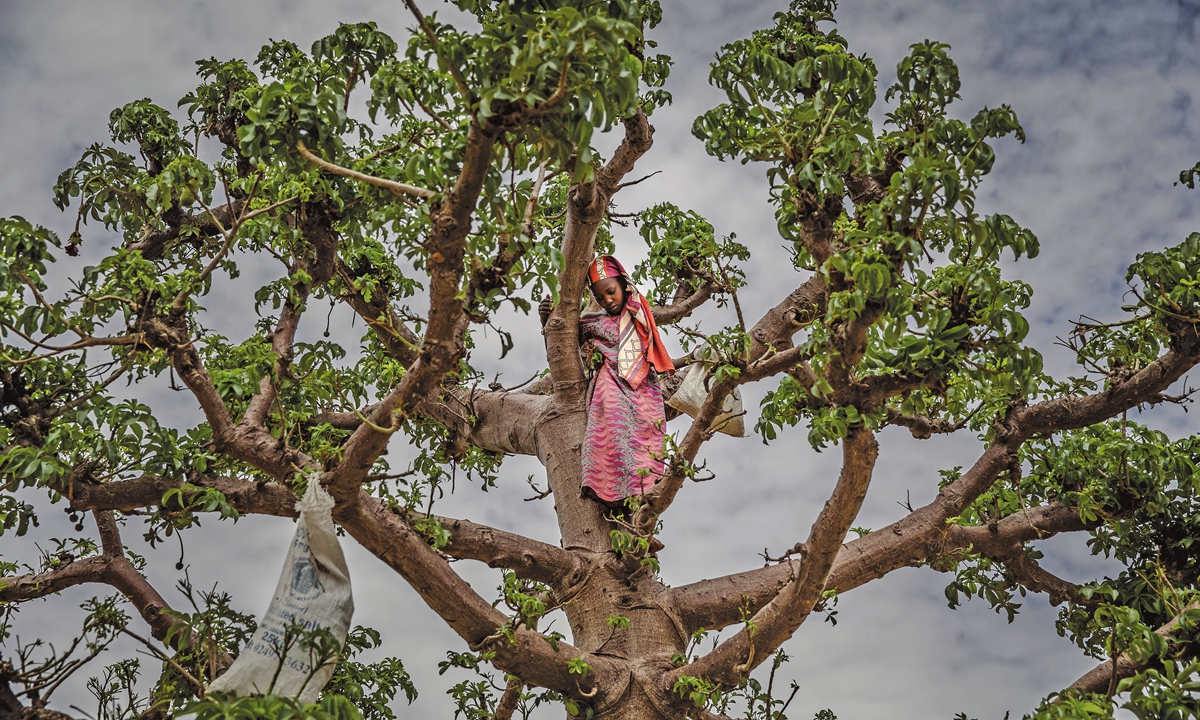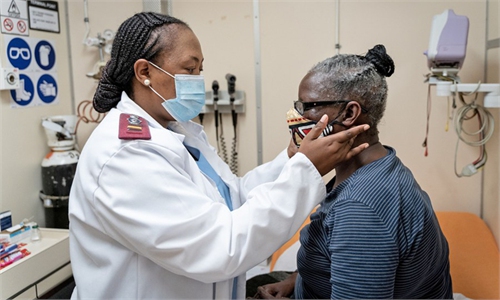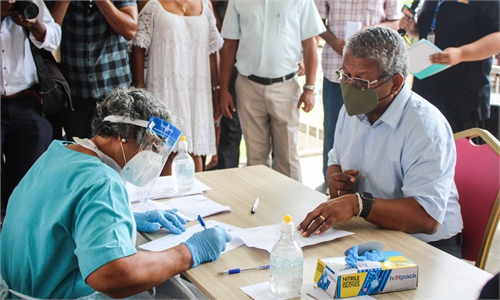Africa’s Great Green Wall aims for fresh growth spurt
Imparting vigor
Growing up in a village in Burkina Faso, Georges Bazongo remembers his parents and neighbors cutting down trees each year to expand their farmland so they could "grow enough food for our families to eat."
He also noticed some trees becoming drier in the drought-prone region, an indication too that the soil was deteriorating as heavy rains washed away its fertile layer. Some of his relatives moved to Cote d'Ivoire in search of a better life, Bazongo, 48, told Reuters.
But things started improving a decade ago when the government and environmental groups helped villagers understand the causes and risks of their degraded land, said Bazongo, director of operations at international charity Tree Aid.

Degraded land is less productive, and releases climate-warming carbon dioxide and nitrous oxide from the soil.
At Bazongo's village, more than 160 kilometers from the capital Ouagadougou, residential people have identified forest areas where tree-cutting is forbidden, developed soil and water conservation methods, and diversified crops, he said.
Now, they get enough food from agriculture, livestock and forest produce, and no longer need to expand their farmland, he added.
The village is part of the Great Green Wall initiative, a regional program that aims to rein in climate change impacts, cut hunger, create jobs and reduce conflict by restoring land across the width of Africa in a belt below the Sahara desert.
"We're lucky to learn these new skills," said Bazongo, whose organization supports the initiative in five countries.
"But what about the other millions of families living in poverty? That means they still continue to expand [farm] land, cut trees, and destroy plant and animal habitats because they can't see any alternatives," he said.
Getting funding to change that behavior has been a challenge, he noted, adding he was "very happy" to hear France's announcement on Monday that development banks and governments had pledged $14.3 billion to speed up Great Green Wall work.
At the One Planet Summit in Paris, French President Emmanuel Macron hailed donors for beating an initial $10 billion target and said France would ensure commitments were upheld.
"We are now standing shoulder to shoulder with... the entire African continent," he said.
Niger-born Salima Mahamoudou, a research associate with the US-based World Resources Institute (WRI) who has seen firsthand the benefits of land restoration in the Sahel, said the promised funding must be turned into "concrete actions on the ground."
To do that, donor governments should help strengthen local leaders and entrepreneurs' capacity to use the money well and bring about change at the community level, she said.
Teething troubles
The initial idea for the Great Green Wall, launched in 2007, was to plant an 8,000 kilometer band of trees spanning 11 key nations from Senegal in the west to Djibouti in the east, to halt the march of desertification.
After early criticism of aspects such as its narrow focus on reforestation, the scheme widened to include other approaches, like creating multipurpose gardens and stabilizing sand dunes to support vegetation, and also expanded to 20 countries.
This week's new funding is a much-needed shot in the arm for the initiative, which aims to restore 100 million hectares of degraded land, sequester 250 million tons of carbon and create 10 million green jobs by 2030.
The Great Green Wall has so far covered only 4 percent of its target area - 4 million hectares - despite being more than halfway toward its final deadline.
A UN status report in 2020 said restoration work needed to speed up to cover 8 million hectares a year, at an annual cost of $3.6 billion-$4.3 billion.
Projects had not been well-monitored nor integrated with national environmental priorities, it added.
"I want to be crystal clear: All those issues will be addressed," Gilbert Houngbo, president of the Rome-based International Fund for Agricultural Development (IFAD), told Reuters in an interview.
On Monday, the UN agency launched a new investment program with the Green Climate Fund to accelerate the Great Green Wall's completion, with projects to help small-scale farmers and agribusinesses, and create jobs.
More than one in five sub-Saharan Africans went hungry in 2020, and with the Sahel's population predicted to double by 2050, millions of rural youth facing falling agricultural yields could fuel migration and conflict, IFAD warned in a statement.
"[With the Great Green Wall] you will be addressing the climate dimension, the food-security dimension, the human-security dimension and the job-creation dimension," Houngbo said.
Good investment
Lars Laestadius of the Global EverGreening Alliance, a coalition of aid and environmental groups working on land restoration, said the Great Green Wall must focus on boosting the prosperity of very poor people where every tree counts for someone's livelihood.
More diversified financing, including from private sources such as impact investors, will be needed for land restoration to become a business carried out by local companies - something that is starting to happen, said WRI's Mahamoudou.
World Bank Group President David Malpass told the Paris summit investing in landscape restoration "makes economic sense." In Niger, for example, every dollar invested brings a return of $6, he noted.
He also noticed some trees becoming drier in the drought-prone region, an indication too that the soil was deteriorating as heavy rains washed away its fertile layer. Some of his relatives moved to Cote d'Ivoire in search of a better life, Bazongo, 48, told Reuters.
But things started improving a decade ago when the government and environmental groups helped villagers understand the causes and risks of their degraded land, said Bazongo, director of operations at international charity Tree Aid.

A girl climbs a Baobab tree while looking for Baobab leaves to be cooked as a meal in Malamawa village, Zinder Region, Niger, on July 30, 2019. Photo: AFP
About a quarter of the Earth's land area is in a bad condition due to natural processes such as erosion and human practices like deforestation and overgrazing, scientists say.Degraded land is less productive, and releases climate-warming carbon dioxide and nitrous oxide from the soil.
At Bazongo's village, more than 160 kilometers from the capital Ouagadougou, residential people have identified forest areas where tree-cutting is forbidden, developed soil and water conservation methods, and diversified crops, he said.
Now, they get enough food from agriculture, livestock and forest produce, and no longer need to expand their farmland, he added.
The village is part of the Great Green Wall initiative, a regional program that aims to rein in climate change impacts, cut hunger, create jobs and reduce conflict by restoring land across the width of Africa in a belt below the Sahara desert.
"We're lucky to learn these new skills," said Bazongo, whose organization supports the initiative in five countries.
"But what about the other millions of families living in poverty? That means they still continue to expand [farm] land, cut trees, and destroy plant and animal habitats because they can't see any alternatives," he said.
Getting funding to change that behavior has been a challenge, he noted, adding he was "very happy" to hear France's announcement on Monday that development banks and governments had pledged $14.3 billion to speed up Great Green Wall work.
At the One Planet Summit in Paris, French President Emmanuel Macron hailed donors for beating an initial $10 billion target and said France would ensure commitments were upheld.
"We are now standing shoulder to shoulder with... the entire African continent," he said.
Niger-born Salima Mahamoudou, a research associate with the US-based World Resources Institute (WRI) who has seen firsthand the benefits of land restoration in the Sahel, said the promised funding must be turned into "concrete actions on the ground."
To do that, donor governments should help strengthen local leaders and entrepreneurs' capacity to use the money well and bring about change at the community level, she said.
Teething troubles
The initial idea for the Great Green Wall, launched in 2007, was to plant an 8,000 kilometer band of trees spanning 11 key nations from Senegal in the west to Djibouti in the east, to halt the march of desertification.
After early criticism of aspects such as its narrow focus on reforestation, the scheme widened to include other approaches, like creating multipurpose gardens and stabilizing sand dunes to support vegetation, and also expanded to 20 countries.
This week's new funding is a much-needed shot in the arm for the initiative, which aims to restore 100 million hectares of degraded land, sequester 250 million tons of carbon and create 10 million green jobs by 2030.
The Great Green Wall has so far covered only 4 percent of its target area - 4 million hectares - despite being more than halfway toward its final deadline.
A UN status report in 2020 said restoration work needed to speed up to cover 8 million hectares a year, at an annual cost of $3.6 billion-$4.3 billion.
Projects had not been well-monitored nor integrated with national environmental priorities, it added.
"I want to be crystal clear: All those issues will be addressed," Gilbert Houngbo, president of the Rome-based International Fund for Agricultural Development (IFAD), told Reuters in an interview.
On Monday, the UN agency launched a new investment program with the Green Climate Fund to accelerate the Great Green Wall's completion, with projects to help small-scale farmers and agribusinesses, and create jobs.
More than one in five sub-Saharan Africans went hungry in 2020, and with the Sahel's population predicted to double by 2050, millions of rural youth facing falling agricultural yields could fuel migration and conflict, IFAD warned in a statement.
"[With the Great Green Wall] you will be addressing the climate dimension, the food-security dimension, the human-security dimension and the job-creation dimension," Houngbo said.
Good investment
Lars Laestadius of the Global EverGreening Alliance, a coalition of aid and environmental groups working on land restoration, said the Great Green Wall must focus on boosting the prosperity of very poor people where every tree counts for someone's livelihood.
More diversified financing, including from private sources such as impact investors, will be needed for land restoration to become a business carried out by local companies - something that is starting to happen, said WRI's Mahamoudou.
World Bank Group President David Malpass told the Paris summit investing in landscape restoration "makes economic sense." In Niger, for example, every dollar invested brings a return of $6, he noted.



